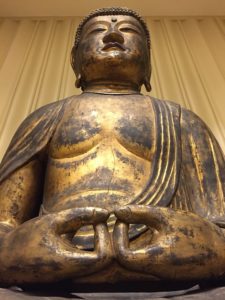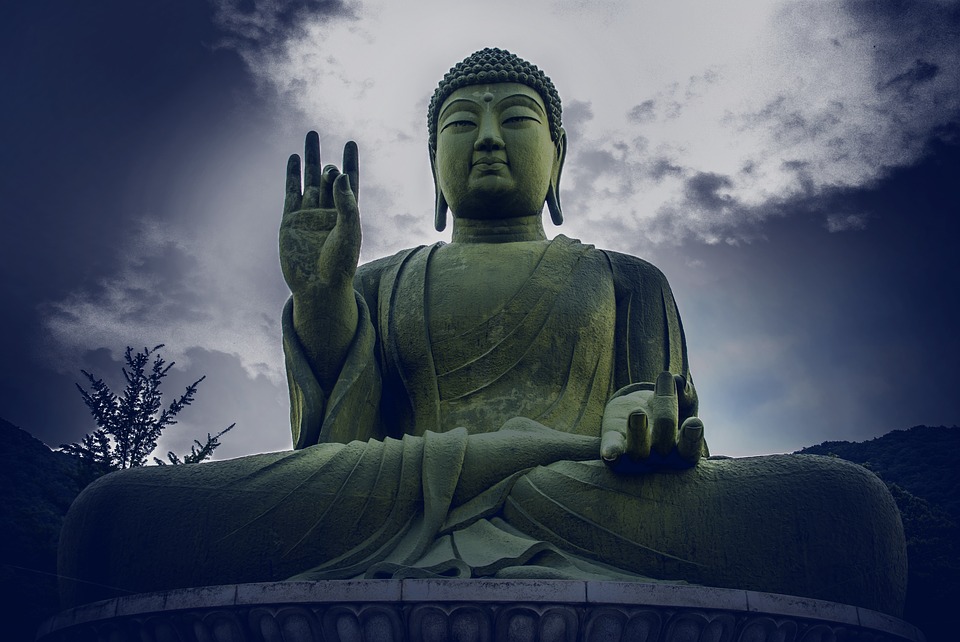Amitabha is a celestial Buddha who is described in the scriptures of the Mahayana, or Greater Vehicle, school of Buddhism. This school of Buddhism lays great emphasis on the Buddha’s teaching that truth and the way of salvation is for all whether one lives in a cave, a monastery, or a house, asserting that the Buddha’s love and compassion are so all-encompassing, that no one will be denied salvation who asks it of the Buddha.
This approach to salvation is in stark contrast to the approach of the Hinayana, or Lesser Vehicle, school (also known as Theravada, or Way of the Elders) which places more emphasis on gaining wisdom and working out one’s salvation by living as a monk and devoting oneself to a life of meditation and study in a monastery.
Mahayana School
The Mahayana school is widespread in China, Japan, Korea, and Vietnam, and many of the concepts that have been developed by this school are also common in Lamaism, the form of Buddhism practiced in Tibet and Mongolia. It is in these countries, where Mahayana is the dominant school that the worship of the Buddha, Amitabha, is concentrated, and this Buddha is the principal Buddha of the Pure Land or Western Paradise sect, one of the many sects that have developed out of the teachings of the Mahayana school.
Infinite Light
Amitabha means infinite light, thus he is frequently referred to as the Buddha of Infinite Light, and the doctrines relating to his worship are primarily to be found in three canonical texts, to wit: the Larger Sutra[1] of Immeasurable Life; the Smaller Sutra of Immeasurable Life; and, the Sutra on the meditations of Amitayus, Amitayus is another name by which the Buddha is known, especially in Tibet, and the meditations being the 48 vows made by the Buddha.
 According to the scriptures, Amitabha was originally a monk, or perhaps a king, whose name was Dhamarkara. Over countless lifetimes as a bodhisattva[2], he had come to possess infinite merits and therefore decided to become a Buddha so that he could possess a buddhakSetra, a Buddha-field, a realm that is brought into existence solely by the Buddha’s merits and exists outside of space and time. He therefore made 48 vows which defined the type of buddhakSetra that he proposed to create, the conditions under which beings might be born into his realm once it had come into existence, and, having been born, what kinds of beings they would be in the new realm. In particular, it is the eighteenth and nineteenth vows made by the Buddha that have made Pure Land Buddhism so popular amongst its adherents.
According to the scriptures, Amitabha was originally a monk, or perhaps a king, whose name was Dhamarkara. Over countless lifetimes as a bodhisattva[2], he had come to possess infinite merits and therefore decided to become a Buddha so that he could possess a buddhakSetra, a Buddha-field, a realm that is brought into existence solely by the Buddha’s merits and exists outside of space and time. He therefore made 48 vows which defined the type of buddhakSetra that he proposed to create, the conditions under which beings might be born into his realm once it had come into existence, and, having been born, what kinds of beings they would be in the new realm. In particular, it is the eighteenth and nineteenth vows made by the Buddha that have made Pure Land Buddhism so popular amongst its adherents.
The Eighteenth vow promises entry into the Pure Land
The eighteenth vow promises entry into the Pure Land for any being in any of the universes who calls upon the Buddha Amitabha for even as few as ten times, whilst the nineteenth vow promises that any being who, at the point of death, calls upon Amitabha, is guaranteed an appearance by the Buddha himself, accompanied by his bodhisattvas as well as other saintly Buddhists, to lead such a one into the Pure Land. The Pure Land, Sukhavati, (i.e. a land possessing happiness) is located in the westernmost parts, far removed from all material creation and, by the power of Amitabha’s vows, it has become possible for all who so desire to be reborn in that land where they will undergo training in the dharma[3], so that such reborn folk will in their turn become bodhisattvas and Buddhas in their turn, able to return to the worlds in order to assist those still in the worlds who require assistance on their journey to enlightenment.
In Tibet and areas where Tibetan Buddhism holds sway, Amitabha is considered to be one of the five Dhyani Buddhas, also known as the Five Great Buddhas, each of which represents one of Buddha’s qualities. Amitabha’s consort in this variant of Buddhism is Pandaravasini, one of the five female Buddhas. Tibetan Buddhism has many famous prayers that are designed to assist one achieve rebirth in Sukhavati, called Dewachen in Tibetan. Also, the Panchen Lama, the second in the hierarchy of Tibetan Buddhism and the Sharampa, the Red Hat Lama, is traditionally believed to be reincarnations of Amitabha.
The name, Amitabha, is derived from compounding two Sanskrit words: Amita i.e. without bounds or infinite, and Abha i.e. light or splendor; thus Amitabha he who possesses light without bound or he who is of infinite splendor. The Buddha is known as Amida Butsu in Japan, in Korea as Amit’a Bul, and in Vietnam as A-di-da Phai.
[1] A Sutra, in Buddhism, is a group of writings, such as the sermons of the Buddha or some other doctrinal work.
[2] One who has attained perfection but has postponed entering into Nirvana so as to help others achieve perfection.
[3] The truth as laid down in the Buddhist scriptures.





